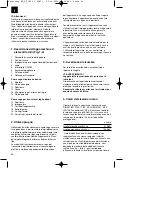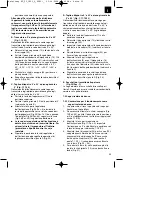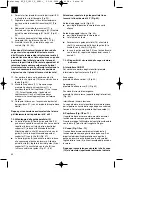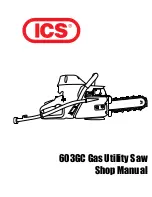
GB
Low positioning edge (Fig. 37)
앬
for sawing flat workpieces
앬
if the saw blade is angled
앬
To fit the parallel stop (14), undo the screw (D),
place the parallel stop (14) on the guide rail (E)
from above and secure it with the screw (D).
(Fig. 39).
앬
If the parallel stop (14) is not in line with the saw
blade (4), adjust it again as described in point
8.1.
7.2.3 Safety equipment for the bench circular
saw
A ON/OFF switch (5)
Press in the sides of red push-button to open the
switch cover (Fig. 41).
To switch on:
Press the green button (I) (Fig. 42)
To switch off:
Press the red button (0) (Fig. 42)
Emergency Stop function:
Press the red button (flap) (Fig. 43)
Zero voltage switch:
The saw is fitted with a zero voltage switch to prevent
it from restarting after a voltage failure. Press the
green button (I) to switch it on again.
B Saw blade guard (Fig. 1 / Item 11)
The saw blade guard must be fitted at all times when
the machine is being used as a bench circular saw. It
protects the user from accidentally touching the saw
blade (4) and catapulted chips.
C Splitter (Fig. 1 / Item 12)
The splitter guard must be swung out at all times
when the machine is being used as a bench circular
saw. It is an important safety device that guides the
workpiece and prevents the kerf closing behind the
saw blade (4) and the workpiece suffering kickback.
Each time you change the machine, check
whether the splitter (12) is fitted in the intervals
shown in Figure 44.
D Push stick (Fig. 2 / Item 9)
The push stick must always be used if the distance
between the stop rail and the saw blade during
longitudinal cuts is less than 120 mm. It is designed to
act as an extension of the operator’s hand to prevent
accidental contact with the saw blade (4).
When it is
not in use the push stick should always be kept on
the saw. (Fig. 45)
Replace a worn or damaged push stick
immediately.
E Push block (Fig. 48)
A push block must always be used if the distance
between the parallel stop (14) and the saw blade (4)
during longitudinal cuts is less than 30 mm. The low
guide face of the stop rail is best used in this case.
The push block is not supplied with the machine.
Replace the push block without delay when it
becomes worn.
7.2.4 Operation as a bench circular saw
앬
When used as a bench circular saw, the
turntable must always be in the 0° position.
앬
The saw is not designed for initial cuts and
concealed cuts.
A Making longitudinal cuts (Fig. 46)
Longitudinal cutting (also known as slitting) is when
you use the saw to cut along the grain of the wood.
Press one edge of the workpiece against the parallel
stop (14) while the flat side lies on the saw bench (2).
The saw blade guard (11) must always be lowered
over the workpiece. When you make a longitudinal
cut, never adopt a working position that is in line with
the cutting direction.
앬
Set the parallel stop (14) to suit the workpiece
height and the desired width (see point 7.2.2)
앬
Set the saw blade height using the knurled screw
(Fig. 35 / Item 13) to suit the workpiece thickness.
앬
Switch on the saw (see also 7.2.3/A)
앬
When you have switched on the saw, wait until
the saw blade (4) has reached maximum speed.
앬
Place your hands (with fingers closed) flat on the
workpiece and push the workpiece along the
parallel stop (14) and into the blade.
앬
Guide at the side with your left or right hand
(depending on the position of the parallel stop)
only as far as the front edge of the saw blade
guard (11).
앬
Always push the workpiece through to the end of
the splitter (12).
앬
The off-cut piece remains on the saw bench until
the blade is back in its position of rest.
앬
Secure long workpieces against falling off at the
end of the cut (e.g. with a roller stand, etc.)
25
Anleitung RT_FF_1825_U_SPK1:_ 23.06.2008 9:42 Uhr Seite 25
















































